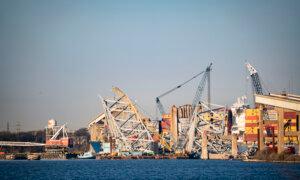BEIJING—A section of a highway collapsed after heavy rains in a mountainous area in southern China, sending cars tumbling down a slope and leaving at least 36 people dead, authorities said Thursday.
The Meizhou city government said that 23 vehicles have been found after a 17.9-meter (58.7-foot) long section of the highway gave way about 2 a.m. on Wednesday. Thirty other people had injuries, none of them life-threatening, a government statement said.
The collapse left a barren scar down a steep slope in an otherwise verdant green forested area. Witnesses told local media they heard a loud noise and saw a wide hole open up behind them after driving past the section just before it collapsed.
Video and photos in local media showed smoke and fire at the scene, with a highway guardrail leaning down into the flames. A pile of blackened cars could be seen on the slope leading down from the highway.
A photo later showed a construction crane lowering a mangled car to the road surface, near three other similarly wrecked vehicles. All appeared to have been burned out.
Over 56 centimeters (22 inches) of rain has fallen in the past four weeks in the county where the roadway collapsed, more than four times as much as last year. Some villages in Meizhou flooded in early April, and the city had seen heavy rain in recent days.
Parts of Guangdong province have seen record rains and flooding in the past two weeks, as well as hail. A tornado killed at least five people in Guangzhou, the provincial capital, last weekend.
Heavy rain and flooding pose a special risk to mountain roadways and highway bridges because of erosion, debris flows, and landslides. China has massively expanded its infrastructure in recent years, adding more than 1 million highway bridges, the world’s largest network of high speed trains and scores of new airports.
In the rush to build, flaws in design and construction methods have frequently come to light, while regular inspections and maintenance are sometimes given short shrift. Dozens have died in recent years in tunnel collapses and floods, including 14 who drowned in subway trains in the central city of Zhenzhou during massive flooding that killed at least 300 people.
The actual number of casualties from such events may be much higher. The actual number of casualties is difficult to verify, as the Chinese regime routinely suppresses or alters information.
Subsequent reports said the system had not been prevented with adequate and other equipment and that officials failed to suspend service as they should have under government directives.
The Chinese regime’s overseas projects such as roads and dams under the Belt and Road Initiative have also been criticized for design problems and poor quality, potentially posing a challenge to its efforts to build its influence in the developing world.







